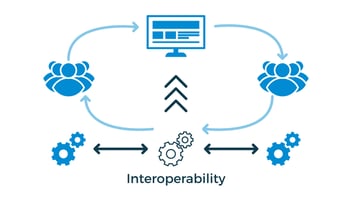As the amount of data and systems used by businesses multiplies, enterprise interoperability becomes more important.
Today, enterprise interoperability is one of the fundamental requirements for a well-functioning organisation. Discover the types of enterprise interoperability that exist and how to ensure interoperability and systems integration.

Interoperability refers to the ability of different systems and applications within an enterprise to work together and share information efficiently. With the increasing amount of data that businesses handle, interoperability is becoming increasingly important to avoid complications and improve productivity.
Each system stores and manages data differently, making it difficult to share information between departments. Interoperability acts as a translator that integrates data from different systems and makes it accessible and useful across the enterprise. It avoids repetitive and manual tasks, improves the management of master data, and facilitates the exchange of information with third parties.
Interoperability is also necessary to ensure data integration, which is essential for making informed decisions and improving business efficiency. Interoperability is achieved through data integration and system integration, customisation for each system, and standardisation of data so that it is uniform and understandable to all.
In practice, interoperability encompasses the following processes:
- Data integration: All systems share and combine their data in a single location.
- Adaptation to each system: Data is adapted to different systems to be accessible from all of them, transforming it into understandable information.
- Data standardisation: Data is standardised by applying rules and relationships between them, avoiding confusing formats and data redundancies for easy subsequent management.
- Data governance: Once the data is accessible and understandable, the information must be managed through effective data governance policies and through control panels, dashboards or self-service BI. It is important to understand the difference between dashboards and self-service BI, as although they may appear similar, they serve different functions.
- Validation of information: Data is also validated to ensure that there are no operational errors or failures.
- Accessibility of information: Finally, the information is prepared to be accessible from all applications and ready for any necessary operation or activity.
Types of enterprise interoperability
When we talk about interoperability, we can refer to different types of integration processes depending on the typology and nature of the information processed.
The three types of interoperability essential to an organisation are:
-
Technical interoperability: This refers to the ability to exchange information and share data in a business environment. It is closely linked to standardisation and solves technical problems of connecting IT systems or services. Technical interoperability requires interconnection services, middleware integration and security services. With technical interoperability, members of an organisation can easily and securely access all platforms and systems and share information efficiently.
-
Legal interoperability: This relates to the socio-economic value of information technologies. To harness this value, it is crucial for regulators to build trust and confidence in business users and developers through open platforms and standards. However, compliance with international laws is becoming increasingly difficult due to the rapid multiplication of systems, applications and enterprise software. For this reason, many companies rely on cloud providers for legal interoperability, as they can delegate or share tasks with the provider, who must ensure appropriate interoperability standards according to international norms.
-
Business interoperability: It is the ability of a business to exchange information with its customers, suppliers, external partners, etc. In other words, the flow of data and information between an enterprise and other enterprises is essential for establishing relationships with other entities and collaborating with external actors. Enterprise interoperability includes the virtual enterprise, the extended enterprise and the organisation's subsystems. There are different levels of enterprise interoperability, from interaction with external partners to the highest level where information exchange is low or no cost. However, a high level of interoperability does not necessarily mean optimisation, as efficiency depends on the effectiveness of information exchange.
The challenges of enterprise interoperability
Enterprise interoperability presents a number of important challenges that need to be addressed to achieve optimal effectiveness and efficiency.
One of the main challenges of enterprise interoperability is system compatibility. Enterprises tend to use different technologies and IT systems that are not always compatible with each other. This means that transferring data and communicating between them can be difficult, which can result in delays, errors and a decrease in productivity. To address this challenge, it is necessary to find solutions that enable the integration and interoperability of systems, such as the use of common standards and the implementation of a systems integration architecture.
Another major challenge is data security. Enterprise interoperability requires the sharing of sensitive and confidential data between different companies, which can put information security at risk. To protect data, appropriate security measures, such as data encryption and user authentication, need to be implemented.
In addition, business interoperability can also be limited by cultural and organisational differences between companies. Differences in business culture and organisational structure can hinder cooperation and communication between companies, which can result in conflicts and delays. To address this challenge, it is important to establish a collaborative culture and a clear and effective organisational structure.
Finally, enterprise interoperability can be limited by lack of resources and budget. Implementing interoperability solutions can be costly and require a significant investment of time and resources. To address this challenge, it is important for enterprises to invest in enterprise interoperability and ensure that they have the necessary resources to implement the purchased solutions.
Conclusion
Interoperability allows companies to use technologies and solutions from different vendors and systems, giving them the flexibility to adapt to market changes. It also allows them to optimise the efficiency and productivity of their operations by enabling different teams and departments to work together more effectively.
Interoperability also helps companies reduce costs and errors in their operations by allowing information to flow more effectively and systems and processes to be more synchronised. In addition, by improving the quality and speed of communications, interoperability can also help improve customer experience and satisfaction.
Ultimately, interoperability is essential to the efficiency, flexibility and adaptability of enterprises in an ever-changing business environment. Companies that can leverage interoperability can improve productivity, reduce costs and improve customer satisfaction, giving them a competitive advantage in the marketplace.



